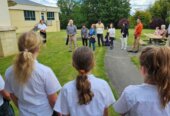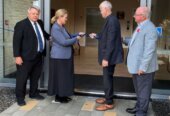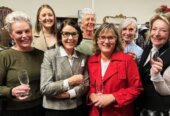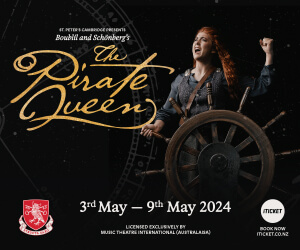
When the Waikato Mounted Rifles celebrated their 150th anniversary in Cambridge last Saturday, no one was more impressed than Rhys Hersom-Gill. The five year old improvised with a stick to join in.
Cambridge revisited its military roots last Saturday with a parade on the town hall plaza marking the 150th anniversary of the Waikato Mounted Rifles.
The July 27 commemoration was organised by Regimental Sergeant Major Dave Freyer and addressed by the Waikato Mounted Rifles retired Commanding Officer, Major Simon Marriott. The reviewing officer was Colonel Glen King, Regimental Colonel for the Royal New Zealand Armoured Corps (RNZAC).
Waipa District Mayor Jim Mylchreest was among invited guests.
In his address, Major Simon Marriott said: “Almost exactly 150 years ago, the following notice appeared in the New Zealand Gazette: ‘His Excellency the Governor has been pleased to accept the services of The Cambridge Mounted Rangers Volunteers. Date of acceptance, 24th July, 1869’.
“And so began the life of the first mounted unit to be raised in the Waikato, and thus the direct military forebears of the present day Waikato Mounted Rifles.”
The Cambridge Mounted Rangers Volunteers disbanded a year later, in 1870, but regrouped soon afterwards as the Cambridge Cavalry Volunteers. The Te Awamutu Cavalry Volunteers followed in 1871 and the Hamilton Cavalry Volunteers in 1880.
Maj Marriott said this led to the creation of the Waikato Mounted Rifle Volunteers in 1897, and to the 4th (Waikato) Mounted Rifles in 1911 when New Zealand’s Volunteer Force was superseded by the Territorial Force.

Cambridge’s Town Hall plaza was the centre on July 27 for a parade marking the sesquicentennial of the Waikato Mounted Rifles. Photo – Michael Jeans.
“Mounted riflemen from the Waikato have served in all the overseas conflicts in which New Zealanders have fought. In the course of writing our regimental history, which he called Waikato Troopers, Richard Stowers uncovered the precise number of casualties suffered by Waikato men while serving in the New Zealand Mounted Rifles during the Anglo-Boer War, and later in the First World War. Eight died in South Africa; 74 at Gallipoli, and 42 in Sinai and Palestine. There were 158 wounded on Gallipoli and in the Middle East.
“It is sadly impossible to discover the exact losses of former Waikato Mounted Rifles servicemen during the Second World War, for unlike in the First World War, the regiment did not send a formed service squadron overseas during the conflict. Aside from the Divisional Cavalry Regiment (Div Cav), to which all nine mounted rifles regiments then in existence contributed, Waikato mounted riflemen were drafted as reinforcements, mainly to armoured units, but also to the infantry and some to the navy and air force. We do know that 29 former Waikato Mounted Rifles soldiers were killed in action with the Div Cav and a further 14 died in other units, but the list is incomplete.”
Maj Marriott said some “remarkable characters” had serviced in the Waikato Mounted Rifles, among them Irish-born Trooper William Mahood who served in the Boer War with the 1st New Zealand Contingent. He was recognised for his bravery and thought to be the oldest Kiwi trooper on enlistment, declaring he was 36 when he was actually 53.

Photo – Michael Jeans.
Another, Cambridge’s Trooper Cocky Swayne, fought at Gallipoli and was wounded several times before going on to serve in France and being commissioned. Trooper Frank Jopling served with the Waikato Mounted Rifles prior to WW2, then joined the Div Cav in 1939. When in Egypt with the Long Range Desert Group the following year, he was wounded and attempted to escape across the desert on foot before being recaptured – he and another soldier had covered 240km in 12 days of extreme hardship.
Captain Jim Wynyard of Te Awamutu was one of three brothers who served in the Waikato Mounted Rifles. He was an All Black, playing in Britain, Canada and Australia, before being killed in action with the Div Cav at the Battle of Alamein in 1942.
Maj Marriott said the unit was awarded a total of 30 battle honours from the Boer War, and both the World Wars. He said that today’s Squadron personnel, now based in Hamilton, continue the tradition of voluntary military service and have, since 2000, served in East Timor, the Solomon Islands, South Korea and Afghanistan.”
A painting by former official Defence Force artist Matt Gauldie, commissioned to mark the 150th anniversary, was unveiled at the end of the ceremony.
The Cambridge Brass Band played at the parade and did the catering.









